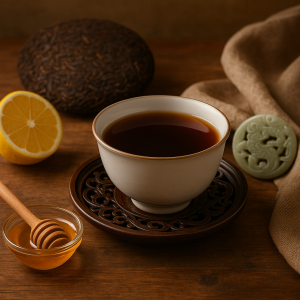Puer Tea: the Ancient Fermented Tea That Detoxes and Revives… and tastes great!
Every once in a while, something as simple as a warm sip can feel like an act of transformation. For me, that moment came the first time I tried Puer Tea—a tea that doesn’t just wake you up, it purifies. Imagine something that feels like a ritual, like slipping on a silk robe, but for your insides. That’s the beauty of this ancient fermented tea.

More than just caffeine in a cup
Many teas are quick to promise energy but leave you jittery or bitter-tongued. Puer is different. Earthy, smooth, and never sharp, it offers a gentle rise of caffeine—a calm energy that supports focus without the crash.
Compared to other Puer teas sold in loose-leaf bricks or cakes, which can vary widely in taste and preparation, this instant form is consistently balanced. No guesswork, no long steeping—just the same refined flavor every single time, hot or iced.
A royal drink through the ages
History tells us that Puer was not a commoner’s drink. In the imperial courts of ancient China, emperors and queens reserved aged Puer for themselves, valuing it like fine jewels. Stored for decades, traded as tribute, it traveled the Tea Horse Road as currency and treasure.
Healers prized it for purification: to cleanse the blood, calm digestion, and restore balance. Monks drank it before meditation, believing it cleared not only the body but also the mind. This tea was—truly—fit for kings and queens.
Green, black… and then there’s Puer
It helps to place Puer in the family of teas.
-
Green tea is fresh and grassy, rich in antioxidants but often higher in tannins that can upset sensitive stomachs.
-
Black tea is bold and malty, energizing but sometimes overly stimulating, with more caffeine than some want.
-
Puer tea is the bridge. Through fermentation, its sharp edges are softened. The result is a tea that feels smooth, earthy, and grounding, with less acidity than green or black.
While green and black teas are celebrated for their health properties, studies show that Puer carries unique compounds from its fermentation process that influence lipid metabolism, gut microbiota, and detoxification in ways the others don’t【NIH: PMC7525353】.
It’s as if green tea is a sprinter, black tea is a bold performer, and Puer is the seasoned sage—calm, grounding, and deeply restorative.
What the scientific evidence whispers today
Modern science is now echoing what tradition always knew:
-
Detox & Liver Support: Puer extract supports the liver’s detox functions and reduces oxidative stress【NIH: PMC4154694】.
-
Weight Balance: Clinical and animal studies show Puer reduces body weight, lowers blood lipid levels, and supports fat metabolism【NIH: PMC7525353】.
-
Gut Harmony: Fermented teas like Puer foster bioactive compounds that encourage a healthier microbiome, digestion, and toxin release.
Turning it into a daily ritual
Here’s how I love to drink it:
-
Morning glow: Hot water, lemon wedge, a drizzle of honey.
-
Afternoon refresh: Cold water, ice cubes, maybe a sprig of mint.
-
Everyday ease: Instant, smooth, and never bitter.
Unlike many Puer options where one cup might taste wildly different from the next, this one is steady, easy, and elegant. That reliability is part of the joy.
The quiet release
Every sip feels like a gentle encouragement to let go—of toxins, heaviness, fatigue, even stress. This isn’t a crash-diet purge; it’s a steady cleansing that becomes a part of your lifestyle.
A closing thought
From emperors’ tables to our modern mugs, Puer tea is more than leaves and caffeine. It’s a bridge between ancient wisdom and today’s science, reminding us that detoxing can be elegant, enjoyable, and sustainable. Sip slowly, savor deeply, and let your body remember what it feels like to be light, radiant, and free.
References
-
Zeng L, et al. Pu-erh tea and its health benefits: A comprehensive review. Food Chem. 2017; 234: 23-34. [NIH: PMC7525353]
-
Wang D, et al. Effects of Pu-erh tea on lipid metabolism and liver health in animal studies. J Agric Food Chem. 2013; 61(47): 11445-11451. [NIH: PMC4154694]
